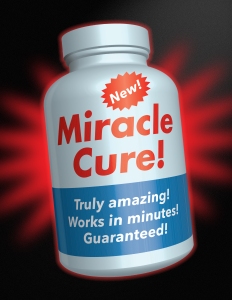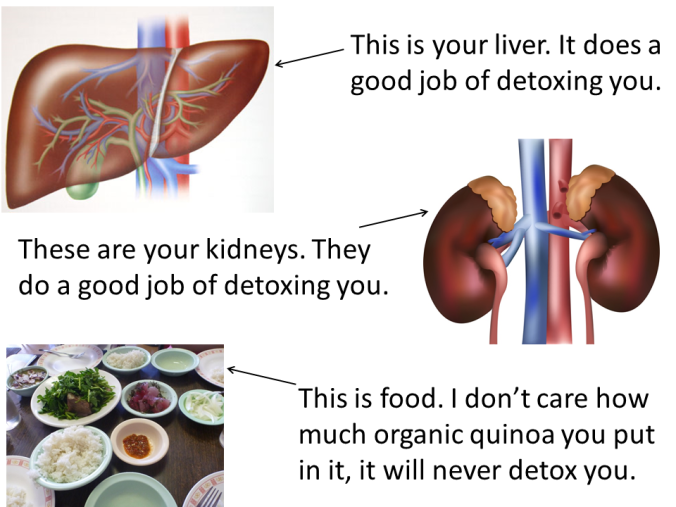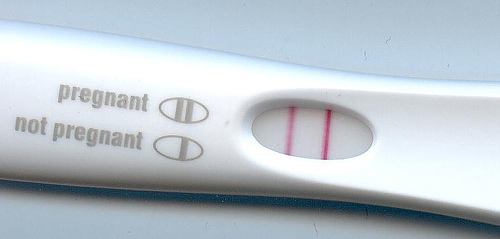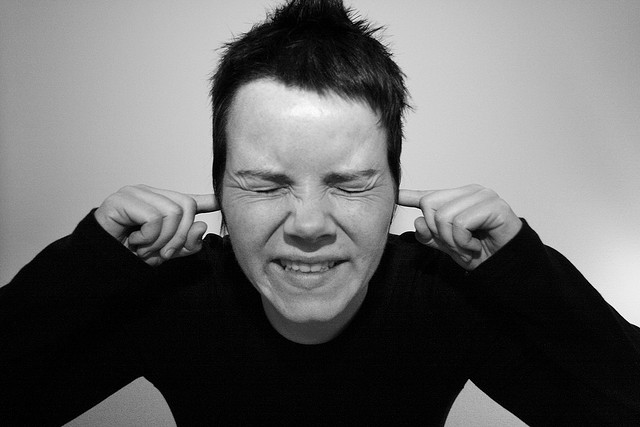
Natural remedies are popular. But are they an appropriate substitute for medication?
The idea of taking medication can be frightening. And as consumers and patients that want to make our own informed health decisions, it’s understandable and even appropriate to question our physicians when they recommend drug treatments. We need to understand the rationale for any medication that’s recommended or prescribed, the benefits of therapy, the side effects, and if there are any other approaches that might be more appropriate. Dietary supplements and natural health products are widely marketed as being safe and effective, and are occupying more and more shelf space in pharmacies, usually right beside the pharmacy counter. Many of my patient encounters in the pharmacy have included a discussion on the merits of drug therapy, versus the supplements that may have flashy packaging and impressive claims of effectiveness.
One encounter from my time working at a local pharmacy still sticks with me. I met a new patient who was anxious and eager to get my advice. He’d been cautioned by his family doctor that he was on the borderline of being diagnosed with diabetes. He had come to the pharmacy seeking a supplement that could help him avoid diabetes and medication. Rather than recommend any supplement, I suggested that the best approach he could probably take would be to lose some weight and get some exercise – it could be more effective than any supplement or drug, and would definitely help his health. He agreed, and then asked me what supplement he could take that could help him with some weight loss.
This type of discussion occurs all the time, and seems more common when there’s a lack of trust in the physician, or when the goals of treatment aren’t understood. The patient, reluctant to accept the physician’s recommendation, heads to the pharmacy for what they believe is a second opinion. In some cases, the patient may question the physician’s advice: “All my physician wants to do is prescribe drugs,” is a statement I’ve heard more than once. In those that are reluctant to accept medical treatment, there’s often a willingness to consider anything that’s available without a prescription – particularly if it’s perceived as “natural.” Natural products and dietary supplements are thought to be gentle, safe, and effective, while medicine may be felt to be unnatural, harsh, and potentially dangerous. Yet when I explain to patients that there’s actually little evidence to suggest most supplements offer any meaningful health benefits, I am sometimes met with puzzled or dismissive looks. The supplement industry’s marketing has been remarkably effective, glossing over the fact that the research done on dietary supplements is overall unconvincing and largely negative when it comes to having anything useful to offer for health.
Given I want to ensure patients are making informed health decisions based on good scientific evidence, I was eager to read a post that naturopath Reuben Dinsmore recently posted on the website of the British Columbia Naturopaths Association (BCNA). Entitled “The Top Five Medications You Shouldn’t Take Without Trying a Natural Alternative First,” Dinsmore states that supplements can offer all the benefits yet none of the side effects of prescription drugs:
Natural supplements, or nutraceuticals, have been given a bad rap lately—which, in some cases, has been absolutely warranted. But natural formulas that actually contain what they claim on the label, and that are formulated to have maximal efficacy, can be equal to their pharmaceutical counterparts. Better yet, they can be just as effective without the laundry list of side effects.
I approached the article with curiosity. Are supplements an appropriate therapy before medication? I have no bias against supplements, but I do have a bias against unsubstantiated claims. I want to know what works, supplement, drug or otherwise. I looked at each recommendation as if it was given to me by a patient in the pharmacy, and evaluate it against the scientific evidence.
Understanding the naturopathic approach
I’ve written multiple posts in the past about treatment claims by naturopaths, and how they stack up against the scientific evidence. Naturopaths offer an array of unconventional health practices like homeopathy, acupuncture and herbalism that are linked philosophically by a belief in vitalism – the prescientific idea we have a “life force”. From this philosophy can sometimes emerge sensible health advice, but it can also be illogical and even potentially harmful. In past posts I’ve looked at the naturopathic perspectives on fake diseases, infertility, autism, prenatal vitamins, vaccinations, allergies, and even scientific facts themselves. As long as a treatment is viewed as being congruent with the naturopathic belief system, it’s acceptably “naturopathic” – no matter what the scientific evidence says. Despite this obvious disconnect from science-based medicine, naturopaths present themselves as primary care providers, just like medical doctors. The BCNA’s own marketing campaign describes naturopaths as “medically trained”:

Britt Hermes is a former naturopath and has written extensively about naturopathy, and her perspective is clear: There are no naturopathic standards of care and naturopathic training is very different than what naturopaths claim. She argues is that naturopathy has too much quackery and that what actually makes naturopathy unique is its embrace of pseudoscience.
So let’s examine the five categories of drugs that Dinsmore says have equally effective natural remedies. He lists statins, antacids, SSRIs (selective serotonin reuptake inhibitors), antihypertensives, and benzodiazepines.
Statins for high cholesterol
Why do we treat it?
High cholesterol has no symptoms. We treat high cholesterol to lower the risk of heart disease: heart attacks, strokes, and death. One’s risk of heart disease goes up with the LDL cholesterol level, along with the total number of heart disease risk factors.
When is drug treatment appropriate?
High cholesterol doesn’t mean that drug treatment is mandatory. An assessment will include age, family history, and other health conditions such as diabetes, heart disease, or a prior heart attack or stroke. Lifestyle changes are important: A healthy diet, an appropriate weight, regular physical exercise, and quitting smoking can also reduce your risk of heart disease. In those at low risk, drug therapy many not be necessary. “Statins” are a class of drugs that reduce LDL cholesterol. In those with a prior heart attack or stroke, the benefits of treatment with drugs like statins are well documented.
What benefits have drugs been shown to offer?
There’s two general uses for statin therapy: primary prevention (avoiding a first heart attack or stroke), and secondary prevention (using a statin in someone that has already had a heart attack or stroke) to reduce the risk of another cardiovascular event. There is good evidence that statins reduce the risk of heart attacks and strokes, when used for both primary and secondary prevention. Much of the debate on the usefulness of statins has focused on the net benefit when used in lower-risk groups. This is a fair question, and one that I’ve discussed at length previously. But what is not in question is that statins have been proven to reduce the risk of heart attacks, stroke, and death.
What does naturopathy suggest?
As per Dinsmore:
High cholesterol is blamed for heart attacks and strokes via formation of arterial plaques. But the real culprit is inflammation, without which the plaques wouldn’t form in the first place. Bottom line: You can lower cholesterol all you want, but as long as there is inflammation present, plaques can still form.
Some common side effects of statins include muscle pain, cognitive impairment, sexual dysfunction, and increased risk of cancer and diabetes.
Nutraceuticals are an alternative to statins. These include: Omega-3 fatty acids (best sourced from wild-caught fish oils) and curcumin (the active component in turmeric). Both are excellent supplements to lower inflammation. Garlic extracts have been proven to improve cholesterol levels as well. Another option I discuss with patients is red rice yeast extract, which is the natural compound statins were derived from in the first place, and works in a similar manner. This product may have side effects; I find that it can be beneficial for some patients, but not all, something I deal with on a patient by patient basis.
What evidence supports the use of naturopathic treatments?
The reason we use drug therapy to treat high cholesterol is to lower the risk of heart attacks, stroke, and death. Consequently, that’s the benefit we want to see when we consider taking any treatment – naturopathic or drug. Statins are proven effective, so that’s the effectiveness we should be looking for if we’re going to use supplements as an alternative. There is no published evidence to demonstrate that garlic extracts or curcurmin supplements can prevent heart attacks and stroke, or reduce the risk of death. The data are a bit more encouraging with omega-3 fatty acids (which, incidentally, exist as both a drug and a supplement with different regulatory standards for each), but whether or not these products actually produce a real survival advantage is not clear. There is a Cochrane review on dietary modifications for the treatment of high cholesterol, in which the authors conclude:
No conclusions can be made about the effectiveness of a cholesterol-lowering diet, or any of the other dietary interventions suggested for familial hypercholesterolaemia, for the primary outcomes: evidence and incidence of ischaemic heart disease, number of deaths and age at death, due to the lack of data on these. Large, parallel, randomised controlled trials are needed to investigate the effectiveness of a cholesterol-lowering diet and the addition of omega-3 fatty acids, plant sterols or stanols, soya protein, dietary fibers to a cholesterol-lowering diet.
Red rice yeast extract is effectively a natural but crude source of the statin drug lovastatin (the active molecules are identical). There are questions about its safety that are exclusive to red yeast rice, but not present with prescription drugs. Why red rice yeast extract would be preferred over a drug product is unclear, unless one puts a priority on something “natural” over something that’s standardized, predictable, and demonstrated to be effective.
What approach has the best evidence?
Statins provide proven benefits, reducing heart attacks, strokes, and the risk of death. Even if a supplement reduces cholesterol levels, real benefits haven’t been established. There’s no obvious reason to use supplements for high cholesterol.
“Antacids” (anti-ulcer medications for gastro-esophageal reflux)
Why do we treat it?
The reflux of stomach contents, often called “heartburn” requires medical attention when there is damage to the esophagus, or there are unpleasant symptoms. The objective of treatment is to repair any tissue damage and/or to reduce the symptoms of heartburn.
When is drug treatment appropriate?
So called “lifestyle” modifications are usually recommended first, and they aren’t always effective. Weight loss (if appropriate) can provide relief, as can elevating the head of the bed for those with heartburn at night. Minimizing specific foods or “triggers” is usually not necessary, but some find this approach helpful. Drug treatment with medications like proton pump inhibitors (PPIs), which suppress stomach acid production, are usually appropriate when symptoms are severe, or where there’s esophageal damage.
What benefits have drugs been shown to offer?
PPIs are among the most effective drugs to treat heartburn and heal esophagitis. PPIs are well tolerated over the short term. When acid production is suppressed for long-term periods (months to years), there are concerns this may predispose people to infections and malabsorption conditions. Whether or not PPIs raise the risk of osteoporosis or hip fractures isn’t clear. Many people find these medications highly effective, but some stay on therapy far longer than necessary. Current guidance suggests the lowest dose should be used for the shortest duration possible to minimize these risks.
What does naturopathy suggest?
As per Dinsmore:
It’s said that five million Canadians suffer from heartburn symptoms weekly. Prescriptions for the acid-blocking drugs PPIs (proton pump inhibitors) accounted for $24 million in BC alone in 2013. Risks of taking these mostly involve nutrient deficiencies from poor absorption DUE TO LOW STOMACH ACID (see the problem here?). Examples include bone fractures from poor calcium absorption or anemia from decreased levels of vitamin B12 or iron. B12 deficiency can also cause dementia and neurological damage. There has also been a correlation shown between PPI use and C. difficile infection, which causes life-threatening diarrhea.
Nutraceuticals: Long story short, most people don’t have too much stomach acid. The problem is the acid they have is getting into the wrong place (the lower esophagus) where it burns. This can be from the muscle between the esophagus and the stomach not closing properly, either from poor tone or insufficient stomach acid, which is the signal for the sphincter to close. Limonene (an extract from citrus peel) helps strengthen this muscle and promotes movement of food downward to the stomach. DGL (an extract from licorice root) stimulates mucus production in the stomach, which acts to coat and protect the sensitive lining of the esophagus.
What evidence supports the use of naturopathic treatments?
Limonene is an ingredient in citrus oils, and is considered “possibly safe” as a supplement by the Natural Medicines database. I could locate no published evidence in PubMed it has been studied for heartburn or GERD. I did find a reference to clinical trials in Alternative Medicine Review, but there’s not a lot of information to review: one trial had 19 adults and had no control group. The other had just 13 participants but was randomized and blinded, noting improvements in heartburn symptoms with limonene. There’s not much safety information on limonene, and it appears to have multiple interactions with drugs. How limonene might work isn’t clear. Long-term effects haven’t been reported.
Deglycyrrhizinated licorice (DGL) is licorice processed to remove the glycyrrhizic acid, which can cause steroid-like side effects when consumed in excess. Short term use of licorice as a supplement is considered “possibly safe” and long-term use is considered “possibly unsafe”. Some branded supplements combining licorice with other herbal ingredients have been studied for the treatment of acid reflux, stomach pain and cramping. How DGL might work isn’t clear. There’s a lack of evidence to suggest DGL is effective.
What approach has the best evidence?
There’s good evidence to show PPIs work, and they work quickly. There are some concerns when used for long-term purposes. The effectiveness of the remedies suggested by Dinsmore is unclear, as is their long-term safety. Given the lack of good evidence showing they work, I wouldn’t recommend the products, but if someone wanted to try them for mild heartburn, they appear to be low risk when used for short-term use.
SSRIs (selective serotonin reuptake inhibitors) for depression
Why do we treat it?
Depression is the most common psychiatric disorder and a major public health issue. It is associated with functional disability and greater risk of death. It frequently recurs.
When is drug treatment appropriate?
We treat depression to put symptoms into remission and to restore baseline (pre-depression) levels of function. The usual initial treatment of depression can include drug therapy or psychotherapy. Psychotherapy alone appears to be just as effective as drug therapy alone. There’s some evidence the combination may be more effective than either approach alone.
What benefits have drugs been shown to offer?
Antidepressants can help with depression, but the magnitude of that benefit has been questioned. The overall advantage of antidepressants over placebo can be modest for mild-to-moderate depression. Selective publication of trials may have led to an overestimate of the efficacy of antidepressants. SSRI’s or selective serotonin reuptake inhibitors are a popular class of antidepressant medications. No particular SSRI is dramatically and consistently superior to any other antidepressant drug in terms of effectiveness, but the side effects can vary. In severe cases of depression, drug therapy is combined with psychotherapy.
What does naturopathy suggest?
As per Dinsmore:
SSRIs (selective serotonin reuptake inhibitors) are the most common class of anti-depressant drugs. One in twelve Canadians will experience major depression in their lifetime, but it’s still one of the most misunderstood conditions. Standard treatment protocols typically target neurotransmitter activity (most commonly serotonin). However, new research indicates the underlying cause may actually be inflammation. Either way, natural medicine has you covered.
Some nutraceuticals to consider are 5-HTP, which is used to make serotonin, with the help of vitamin B6. The herb St. John’s Wort has been studied extensively and appears to work in the same way as SSRIs. Both 5-HTP and St. John’s wort have shown similar efficacy to SSRIs when given for mild to moderate depression. And as I mentioned earlier, omega-3 fatty acids and curcumin decrease inflammation throughout the body, including the brain.
Side effects of SSRIs include sexual dysfunction, weight gain, and worsened/chronic depression. St. John’s wort also has a side effect which should be considered if taking other medications—it impacts liver function, which can result in either higher or lower blood medication levels.
What evidence supports the use of naturopathic treatments?
5-HTP is considered “possibly effective” for the treatment of depression by the Natural Medicines database. It notes:
Overall, despite the preliminary beneficial effects shown in clinical research, the trials to date are generally small and have methodological problems or a lack of generalizability to mixed populations of depressed people. More higher-quality studies in larger patient populations are needed to confirm these result.
St. John’s Wort is considered to be “likely effective” for the treatment of depression by the Natural Medicines database. It’s an interesting natural product that is used widely for antidepressant effects. Trials have many limitations, but the data suggest that SJW may be as effective as SSRIs, but the evidence is less consistent. However, it’s not recommended in most treatment guidelines for many of the reasons discussed before at this blog: preparations of the product are often not standardized, supplement manufacturing quality is not clear, and the dosing may consequently not be predictable. Moreover, St. John’s Wort causes a wide array of drug interactions with other medications, making it difficult to use safely.
What approach has the best evidence?
Overall, there’s better evidence with the SSRIs compared to 5-HTP and St. John’s Wort. However, a decision to use St. John’s Wort is effectively a decision to use medicine, so unsupervised, unmonitored use, when treating depression, should be avoided.
Anti-hypertensives for the treatment of high blood pressure
Why do we treat it?
Untreated high blood pressure, or hypertension, can increase your risk of heart attack, stroke, heart failure, and kidney disease. We treat hypertension to reduce these risks.
When is drug treatment appropriate?
Non-drug treatments are usually considered before drug therapy, and can reduce the need for medication. Weight reduction (when necessary), quitting smoking, avoiding excessive alcohol, a healthy, reduced-salt diet, and regular exercise are all low-risk strategies that can be beneficial. Drug therapy can have side effects. People are usually unwilling to tolerate side effects for a symptomless condition, unless there is a good reason to take medication. There is good evidence that drug therapy provides real benefits to those with hypertension that can’t be controlled by lifestyle changes.
What benefits have drugs been shown to offer?
When drug treatment is considered appropriate (usually when blood pressure exceeds 140/90), there are multiple treatment options that may be appropriate. From Up-to-Date:
In large-scale randomized trials, antihypertensive therapy produces a nearly 50 percent relative risk reduction in the incidence of heart failure, a 30 to 40 percent relative risk reduction in stroke, and a 20 to 25 percent relative risk reduction in myocardial infarction.
The absolute benefit is less impressive, but still real: There’s an approximate 2% reduction in heart attacks and strokes. The benefits of medical treatment are not as clear in those with mild hypertension, those with few risk factors, or the frail elderly.
What does naturopathy suggest?
As per Dinsmore:
Hypertension (i.e., high blood pressure) affects 6 million Canadians, and is responsible for approximately 13 per cent of all deaths. Various classes of anti-hypertensives include diuretics, ACE inhibitors, angiotensin II receptor blockers (ARBs). Diuretics increase urine output, which can negatively affect sodium and potassium levels, which can cause muscle cramps. ACEIs and ARBs may both cause a chronic dry cough. All anti-hypertensives can cause dizziness, headache and low blood pressure.
Again, there are many nutraceutical options for patients to consider, such as CoQ10, magnesium, garlic extracts, omega-3 fatty acids, L-arginine and vitamin C. All of these have all been shown to lower high blood pressure by various means. Dandelion leaf is an effective diuretic that doesn’t lower potassium levels.
What evidence supports the use of naturopathic treatments?
I could find no published evidence that coenzyme-q10, magnesium, garlic, omega-3 fatty acids, l-arginine, or vitamin C supplements reduce the risk of heart attacks, stroke, heart failure, or kidney disease. There is some evidence to show that eating fatty fish (a source of omega-3 fatty acids) can reduce the risk of heart disease or stroke. Omega-3 supplements (also discussed above for hypercholesterolemia) may modestly reduce blood pressure. None of the products listed are considered both safe and effective for treatment of hypertension by the Natural Medicines database. I could find no published evidence that demonstrates dandelion leaf is an effective hypertension treatment.
What approach has the best evidence?
The only reason to treat hypertension with a drug or supplement is to reduce the risk of a future catastrophic event. If medicine is necessary, there’s little reason to choose a “natural” remedy first, as the real-world benefits of supplements have not been proven.
Benzodiazepines for anxiety and insomnia
Why do we treat it?
The term “anxiety” describes worries and fears that are difficult to control and can cause debilitating effects. Insomnia describes difficulty falling asleep or staying asleep. We treat both to reduce the consequences of these conditions, and to restore normal functioning.
When is drug treatment appropriate?
After a workup for underlying causes of anxiety or insomnia, drug therapy might be considered after options like lifestyle changes and cognitive behavioral therapy have been attempted. Benzodiazepines are a class of drugs that can be useful treatments for anxiety and insomnia, though they are usually not the first choice for either condition. There are justified concerns about dependence and tolerance with benzodiazepines, reinforcing the importance of using these medications cautiously and when the benefits are expected to outweigh the risks.
What benefits have drugs been shown to offer?
Benzodiazepines can work quickly and can be effective in anxiety where there’s a poor response to other medications. They are also effective insomnia treatments, with some taking effect within minutes.
What does naturopathy suggest?
As per Dinsmore:
Benzodiazepines are a class of drugs most often prescribed for anxiety disorders and insomnia. They work by binding to receptors for GABA, a neurotransmitter in the brain that calms activity of the nervous system. Interestingly, this is the same mechanism by which alcohol acts in the brain. One obvious effect of benzodiazepines is sedation—great when the treatment target is insomnia. Not so great when you just want to decrease your anxiety but still function. Other side effects include dizziness, loss of balance, and even cognitive impairment at higher doses. They also have a significant risk of developing physical or psychological dependence and rebound anxiety when discontinued.
This is an area where you should have a thorough workup with your naturopathic doctor and consider the options that are right for you. You can take GABA as an alternative (but there’s mixed evidence on whether or not it actually gets into the brain), or herbs such as passionflower (which has the same mechanism of action as benzodiazepines). Other herbs include valerian, chamomile, kava, and many others.
What evidence supports the use of naturopathic treatments?
Up-to-Date has a nice summary:
A variety of herbal products are purported to be useful for insomnia. There is little evidence from randomized controlled trials about the efficacy of many herbals, however, and for those that have been well studied (eg, valerian), there is little evidence of benefit. A meta-analysis that included 14 randomized trials in over 1600 patients found no significant difference between any herbal medicine and placebo on any of 13 clinical efficacy measures of insomnia [94]. The majority of the trials (11 out of 14) studied valerian; chamomile, kava, and wuling were studied in one trial each. Unlike the other herbals studied, valerian was associated with a greater number of adverse events per person compared with placebo. Valerian may also produce hepatotoxic effects [1]. Contamination with undesirable substances poses a problem for many such natural remedies.
And for natural treatments of anxiety, Up-to-Date notes:
None of the herbal remedies described here been shown in clinical trials to be clearly effective or ineffective for anxiety symptoms or disorders. Trials suggest that kava and chamomile may reduce anxiety in some people with generalized anxiety disorder (GAD). Findings from trials of valerian, passion flower, and St. John’s wort are either mixed or negative. Patients may wrongly equate “herbal” with terms such as “good,” “weak,” or “healthy” in evaluating these remedies. These perspectives underestimate their potential risks; some herbs can be potent, poisonous, or addictive. Potentially serious adverse effects of herbal remedies discussed here include hepatotoxicity with kava and anticoagulation with chamomile. It is not known if these remedies are safe or unsafe during pregnancy.
What approach has the best evidence?
It’s understandable to want to avoid benzodiazepines, but they can provide real and demonstrated benefit in select circumstances with close monitoring from a physician. There’s a lack of evidence to demonstrate the efficacy and safety of any of the herbal remedies recommended for the treatment of anxiety or insomnia.
Conclusion: The evidence simply doesn’t support these natural treatments
Naturopaths claim that they can effectively manage medical conditions with “natural” approaches, but the evidence supporting these recommendations has been consistently shown to be absent or weak. It may be that the treatment goals are not understood, which may explain why therapies without any demonstrated benefit are being recommended before proven therapies. In some cases, avoiding drug therapy and using natural remedies may be harmful. In light of the recommendations above, it seems prudent to discuss any naturopathic advice with a health professional like a pharmacist or physician before making any decision to delay medically-recommended drug therapy, or substitute a natural remedy or dietary supplement.
This is a cross-post from Science-Based Medicine. Comments are open there.
Photo from flickr user Ryan Somma used under a CC licence.
Like this:
Like Loading...
Click for detailed story

 Method
Method Method:
Method: Method:
Method: Method:
Method:
















